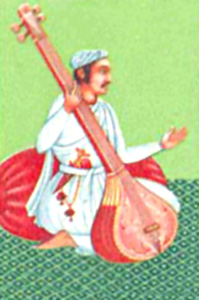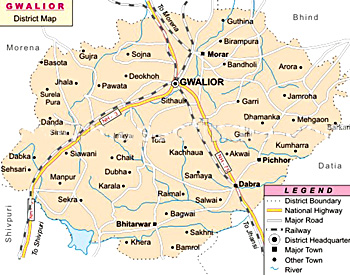 Gwalior District is one of the tourist attractive districts in Madhya Pradesh State near Agra. The nucleus of Gwalior is a citadel crowning an isolated rock about 91 m (300 ft) high, 3.2 km long, and 823 m (2700 ft) wide. Gwalior was the capital of the former princely State of Gwalior until 1948 and the summer Capital of Madhya Bharat State from 1948 to 1956. When Madhya Bharat became part of Madhya Pradesh, it becomes separate district.
Gwalior District is one of the tourist attractive districts in Madhya Pradesh State near Agra. The nucleus of Gwalior is a citadel crowning an isolated rock about 91 m (300 ft) high, 3.2 km long, and 823 m (2700 ft) wide. Gwalior was the capital of the former princely State of Gwalior until 1948 and the summer Capital of Madhya Bharat State from 1948 to 1956. When Madhya Bharat became part of Madhya Pradesh, it becomes separate district.
History of Gwalior District
The history of Gwalior is traced back to a legend in 8th century AD when a chieftain known as Suraj Sen was struck by a deadly disease. Later, a hermit-saint "Gwalipa" cured him. As a gratitude for that incidence, he had found this city by his name. The new city of Gwalior became existence over the centuries. The cradle of great dynasties ruled the city Gwalior. Dynasties like the Tomars, Marwahs and Marathas had ruled over Gwalior in the early days. With different dynasty, the city gained a new dimension from the warrior kings, poets, musicians, and saints who contributed to making it renowned throughout the country. The city is also the setting for the memorials of freedom fighters such as Tantia Tope and the indomitable Rani of Jhansi. Today the old settings stand side by side with the trappings of modernity.
Geography of Gwalior District
Gwalior district has an area of 5214 square kilometres. Gwalior District is surrounded by Mornea District in the north. Shivpuri District is located towards the west of Gwalior District. Bhind District lies to the east and Datia District is in the south. Gwalior District has three sub-divisions namely Gwalior, Dabra and Bhitarwar. In addition, the four development blocks of Gwalior are Ghatigaon (Famous for Ghatigaon Wildlife Sanctuary), Morar, Dabra and Bhitarwar.
 Demography of Gwalior District
Demography of Gwalior District
According to the Population Census in 2011, Gwalior District had a population of 2,030,543. Out of which the male and female constituted 1,090,647 and 939,896 respectively. Gwalior District population constituted 2.80 percent of total population of Madhya Pradesh. The average literacy rate of Gwalior in 2011 was 77.93 percent According to the gender classification, the male and female literacy rates were 86.28 and 68.29 percent respectively. The total literates in Gwalior District were 1,384,434 of which male and female were 821,315 and 563,119 respectively.
Culture of Gwalior District
Gwalior is blessed with classical music maestro Miya Tansen, who was the famous musician in the court of one of the greatest Mughal Emperors in India, Emperor Akbar. In the memory of Tansen, Tansen Samaroh Programme takes place every year and the classical music stars participate in this programme and entertain the people of Gwalior with their outstanding performance. In addition, the Gwalior Trade Fair takes place every year in the month of December-January.
Tourism of Gwalior District
Tourism in the district of Gwalior is well flourished. This is because the old city is covered with white sandstone mosque, palaces, rock temples and statues of archaeological and architectural interest. Some of the well-known places of interest in Gwalior are Gwalior Fort, Gujari Mahal, Man Mandir Palace, Tomb of Ghaus Mohammed, Sarod Gharand Jai Vilas Palace and Museum.






